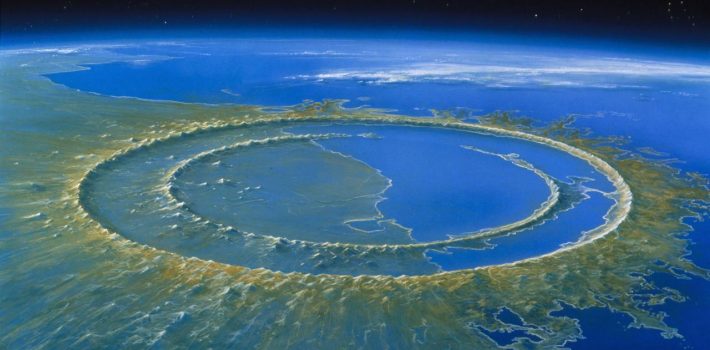The Chicxulub Crater
The Chicxulub crater in the Yucatan Peninsula in Mexico is considered one of the largest impact craters on Earth. It is 180 km in diameter, 10 km deep and was formed about 65 million years ago. It has been linked to a mass extinction of dinosaurs and plant life often associated with the K-T boundary.
The crater was not detected until the 1970s because it was buried beneath a km of other rocks and debris. Glen Penfield was searching for oil in the vicinity when he developed a theory of its existence. His findings were significant, but he could not gather enough evidence to prove the area was an impact crater until he made contact with Alan Hildebrand. His evidence included: shocked quartz, tektites, and a magnetic anomaly in the area.
The impactor, a massive asteroid or comet, is believed to have been at least 10 km in diameter and would have crashed into the Earth with 100 million megatons of force. The atomic bombs dropped during WWII yielded about 0.04 megatons combined. You can see how a 100 million megaton explosion could have changed the prehistoric world. Scientists believe that the impact itself probably killed all life with 100 km immediately. The material ejected (ejecta) into the atmosphere would have blocked out sunlight around a large portion of the globe, immediately lowering the temperatures everywhere. Without the sunlight, plant life began dying. That means that the herbivores probably died first, leaving the carnivores with a very short supply of food. Low temperatures and encroaching ice would have killed many more species and brought hundreds of other to the brink of extinction.
By studying the K-T boundary, a thin dark line found in layers of sediment around the world, scientists are able to piece together the events that are related to the extinction of 70% of the life on Earth in a very short period of time. Why is the K-T boundary so significant? When scientists studied the K-T boundary around the world, they found that it had a much higher concentration of iridium than normal, up to 130 times the amount expected. Iridium is rare on Earth because it sank into the planetary core as it was forming, but iridium can still be found in large concentrations in asteroids. When geologists compared the concentrations of iridium in the K-T boundary, they found it matched the levels found in meteorites.
Some scientists believe that the Chicxulub crater is only one of several impact craters that are related to the K-T extinction event. Others argue that a high level of volcanic activity is to be blamed. Some even present evidence that both theories combined to nearly destroy life here on Earth. Events like this are why NASA keeps an eye on near Earth asteroids today.


Leave a Comment